Principles of Administration Report - Detailed Analysis
VerifiedAdded on 2020/06/06
|15
|2605
|184
Report
AI Summary
This report provides a detailed overview of the principles of administration, covering various aspects crucial for effective office management and organizational efficiency. The report begins by outlining legal requirements related to equality, discrimination, and employment rights, followed by a discussion on office resources, workflow management, and essential facilities. It delves into health and safety regulations, highlighting responsibilities and relevant legislation. Furthermore, the report examines the importance of minutes in meetings, discussing their legal implications, different types (resolution, narrative, action), and best practices for production. It also explores various types of meetings, including formal and informal gatherings, and the roles and responsibilities of key personnel such as the chairperson, treasurer, and attendees. The report then focuses on the significance of setting targets, clarifying team member roles, and quality management techniques. Finally, it covers event planning, including characteristics, information sources, and requirements for successful conferences, seminars, and promotional events. The report concludes by providing resources for the events.
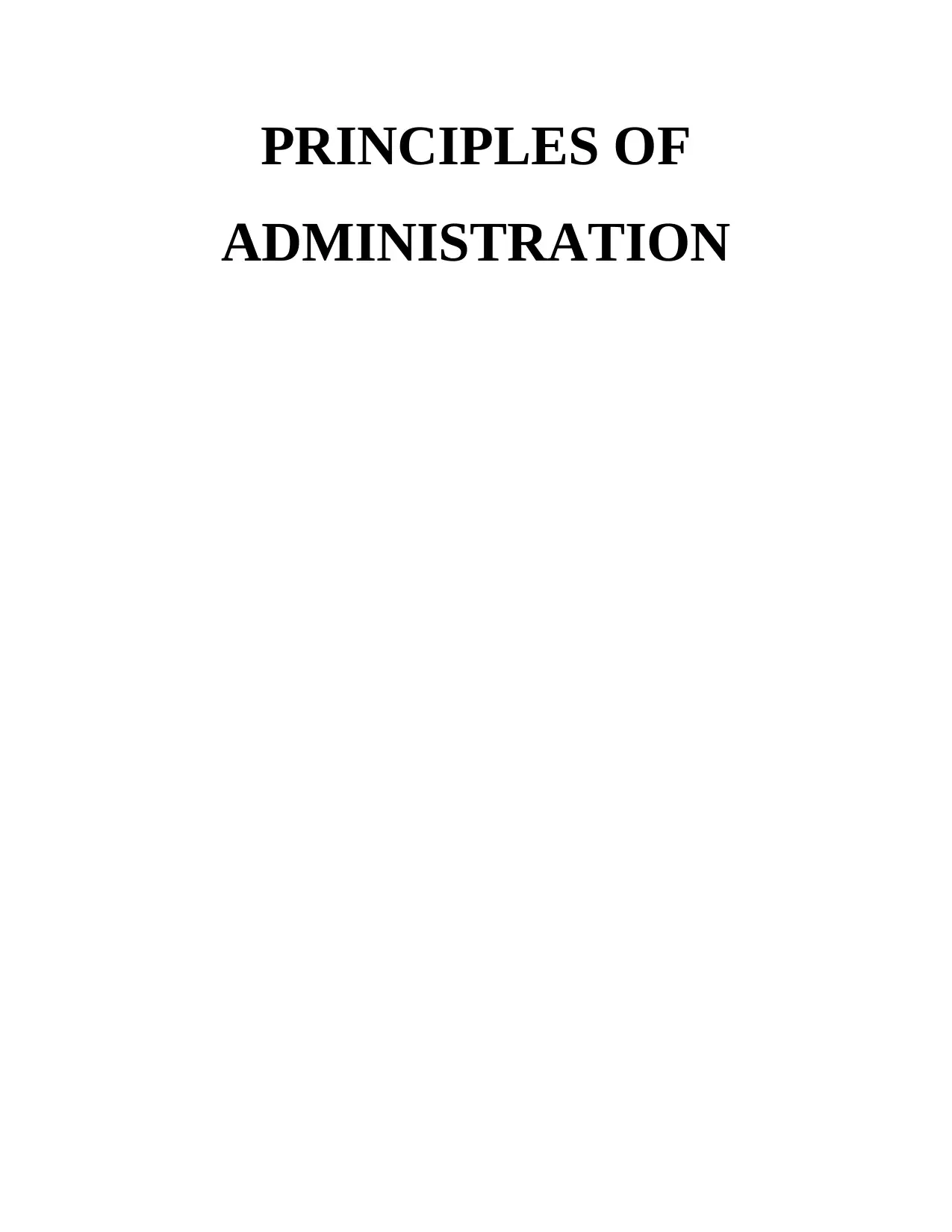
PRINCIPLES OF
ADMINISTRATION
ADMINISTRATION
Paraphrase This Document
Need a fresh take? Get an instant paraphrase of this document with our AI Paraphraser
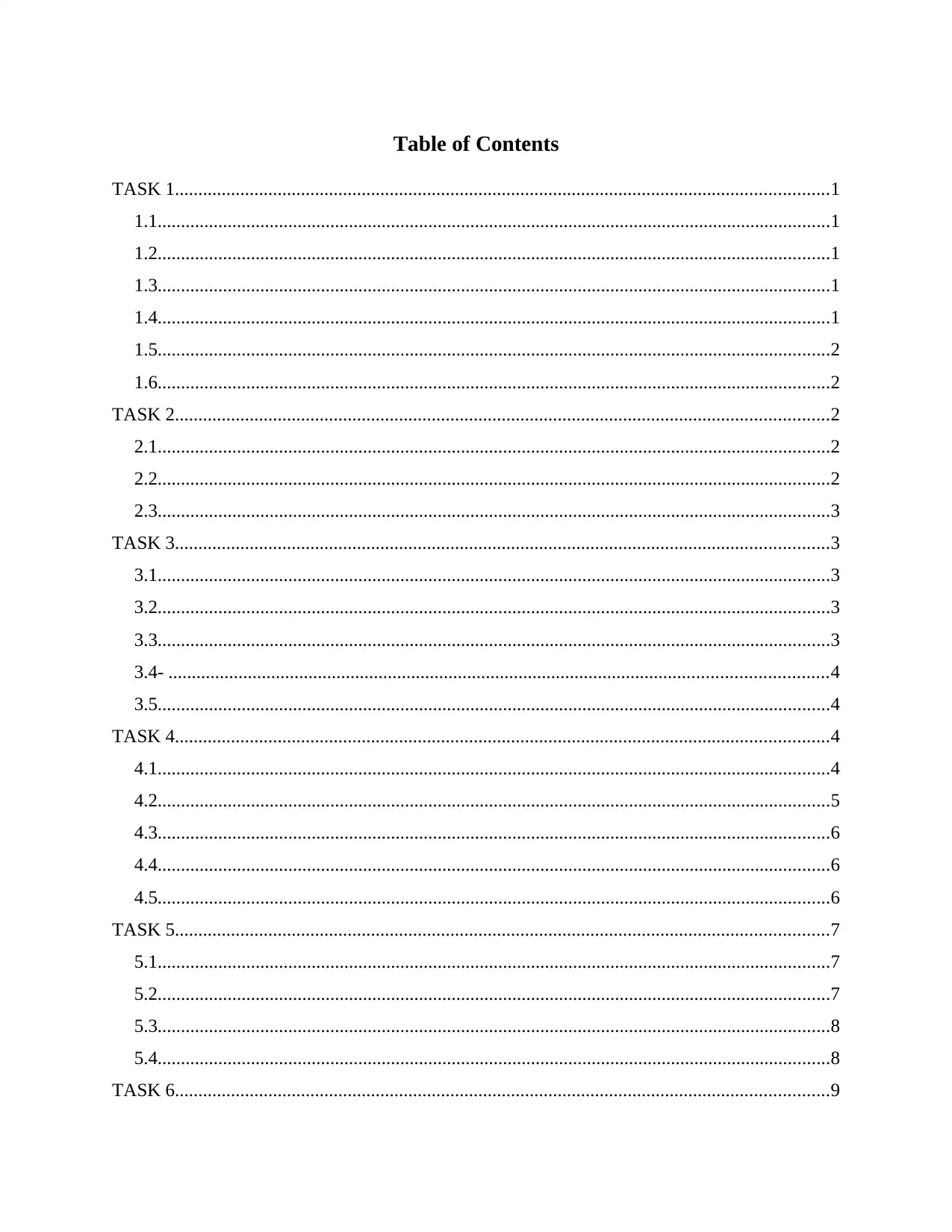
Table of Contents
TASK 1............................................................................................................................................1
1.1................................................................................................................................................1
1.2................................................................................................................................................1
1.3................................................................................................................................................1
1.4................................................................................................................................................1
1.5................................................................................................................................................2
1.6................................................................................................................................................2
TASK 2............................................................................................................................................2
2.1................................................................................................................................................2
2.2................................................................................................................................................2
2.3................................................................................................................................................3
TASK 3............................................................................................................................................3
3.1................................................................................................................................................3
3.2................................................................................................................................................3
3.3................................................................................................................................................3
3.4- .............................................................................................................................................4
3.5................................................................................................................................................4
TASK 4............................................................................................................................................4
4.1................................................................................................................................................4
4.2................................................................................................................................................5
4.3................................................................................................................................................6
4.4................................................................................................................................................6
4.5................................................................................................................................................6
TASK 5............................................................................................................................................7
5.1................................................................................................................................................7
5.2................................................................................................................................................7
5.3................................................................................................................................................8
5.4................................................................................................................................................8
TASK 6............................................................................................................................................9
TASK 1............................................................................................................................................1
1.1................................................................................................................................................1
1.2................................................................................................................................................1
1.3................................................................................................................................................1
1.4................................................................................................................................................1
1.5................................................................................................................................................2
1.6................................................................................................................................................2
TASK 2............................................................................................................................................2
2.1................................................................................................................................................2
2.2................................................................................................................................................2
2.3................................................................................................................................................3
TASK 3............................................................................................................................................3
3.1................................................................................................................................................3
3.2................................................................................................................................................3
3.3................................................................................................................................................3
3.4- .............................................................................................................................................4
3.5................................................................................................................................................4
TASK 4............................................................................................................................................4
4.1................................................................................................................................................4
4.2................................................................................................................................................5
4.3................................................................................................................................................6
4.4................................................................................................................................................6
4.5................................................................................................................................................6
TASK 5............................................................................................................................................7
5.1................................................................................................................................................7
5.2................................................................................................................................................7
5.3................................................................................................................................................8
5.4................................................................................................................................................8
TASK 6............................................................................................................................................9

6.1................................................................................................................................................9
6.2................................................................................................................................................9
6.3................................................................................................................................................9
6.4..............................................................................................................................................10
6.5..............................................................................................................................................10
REFERENCES .............................................................................................................................11
6.2................................................................................................................................................9
6.3................................................................................................................................................9
6.4..............................................................................................................................................10
6.5..............................................................................................................................................10
REFERENCES .............................................................................................................................11
⊘ This is a preview!⊘
Do you want full access?
Subscribe today to unlock all pages.

Trusted by 1+ million students worldwide
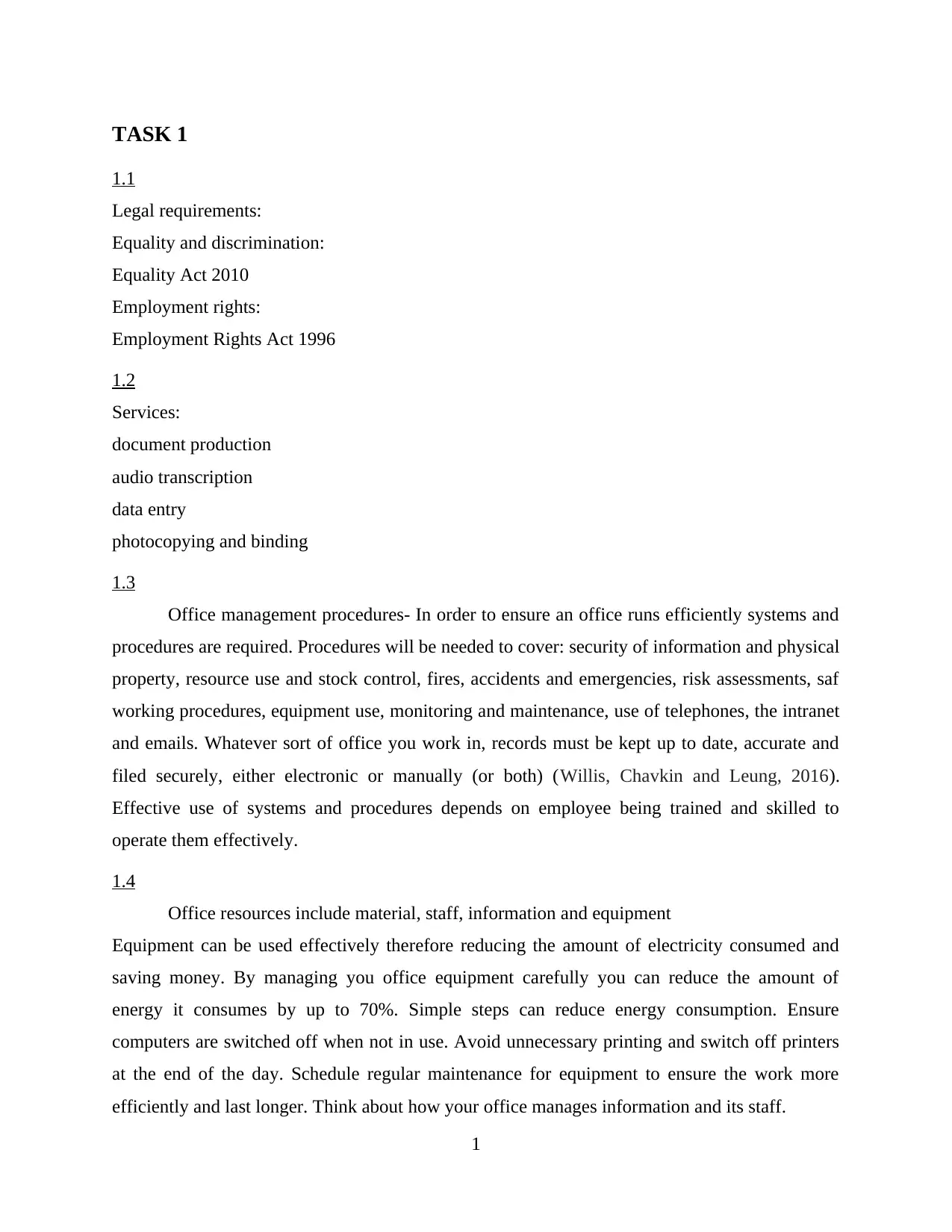
TASK 1
1.1
Legal requirements:
Equality and discrimination:
Equality Act 2010
Employment rights:
Employment Rights Act 1996
1.2
Services:
document production
audio transcription
data entry
photocopying and binding
1.3
Office management procedures- In order to ensure an office runs efficiently systems and
procedures are required. Procedures will be needed to cover: security of information and physical
property, resource use and stock control, fires, accidents and emergencies, risk assessments, saf
working procedures, equipment use, monitoring and maintenance, use of telephones, the intranet
and emails. Whatever sort of office you work in, records must be kept up to date, accurate and
filed securely, either electronic or manually (or both) (Willis, Chavkin and Leung, 2016).
Effective use of systems and procedures depends on employee being trained and skilled to
operate them effectively.
1.4
Office resources include material, staff, information and equipment
Equipment can be used effectively therefore reducing the amount of electricity consumed and
saving money. By managing you office equipment carefully you can reduce the amount of
energy it consumes by up to 70%. Simple steps can reduce energy consumption. Ensure
computers are switched off when not in use. Avoid unnecessary printing and switch off printers
at the end of the day. Schedule regular maintenance for equipment to ensure the work more
efficiently and last longer. Think about how your office manages information and its staff.
1
1.1
Legal requirements:
Equality and discrimination:
Equality Act 2010
Employment rights:
Employment Rights Act 1996
1.2
Services:
document production
audio transcription
data entry
photocopying and binding
1.3
Office management procedures- In order to ensure an office runs efficiently systems and
procedures are required. Procedures will be needed to cover: security of information and physical
property, resource use and stock control, fires, accidents and emergencies, risk assessments, saf
working procedures, equipment use, monitoring and maintenance, use of telephones, the intranet
and emails. Whatever sort of office you work in, records must be kept up to date, accurate and
filed securely, either electronic or manually (or both) (Willis, Chavkin and Leung, 2016).
Effective use of systems and procedures depends on employee being trained and skilled to
operate them effectively.
1.4
Office resources include material, staff, information and equipment
Equipment can be used effectively therefore reducing the amount of electricity consumed and
saving money. By managing you office equipment carefully you can reduce the amount of
energy it consumes by up to 70%. Simple steps can reduce energy consumption. Ensure
computers are switched off when not in use. Avoid unnecessary printing and switch off printers
at the end of the day. Schedule regular maintenance for equipment to ensure the work more
efficiently and last longer. Think about how your office manages information and its staff.
1
Paraphrase This Document
Need a fresh take? Get an instant paraphrase of this document with our AI Paraphraser
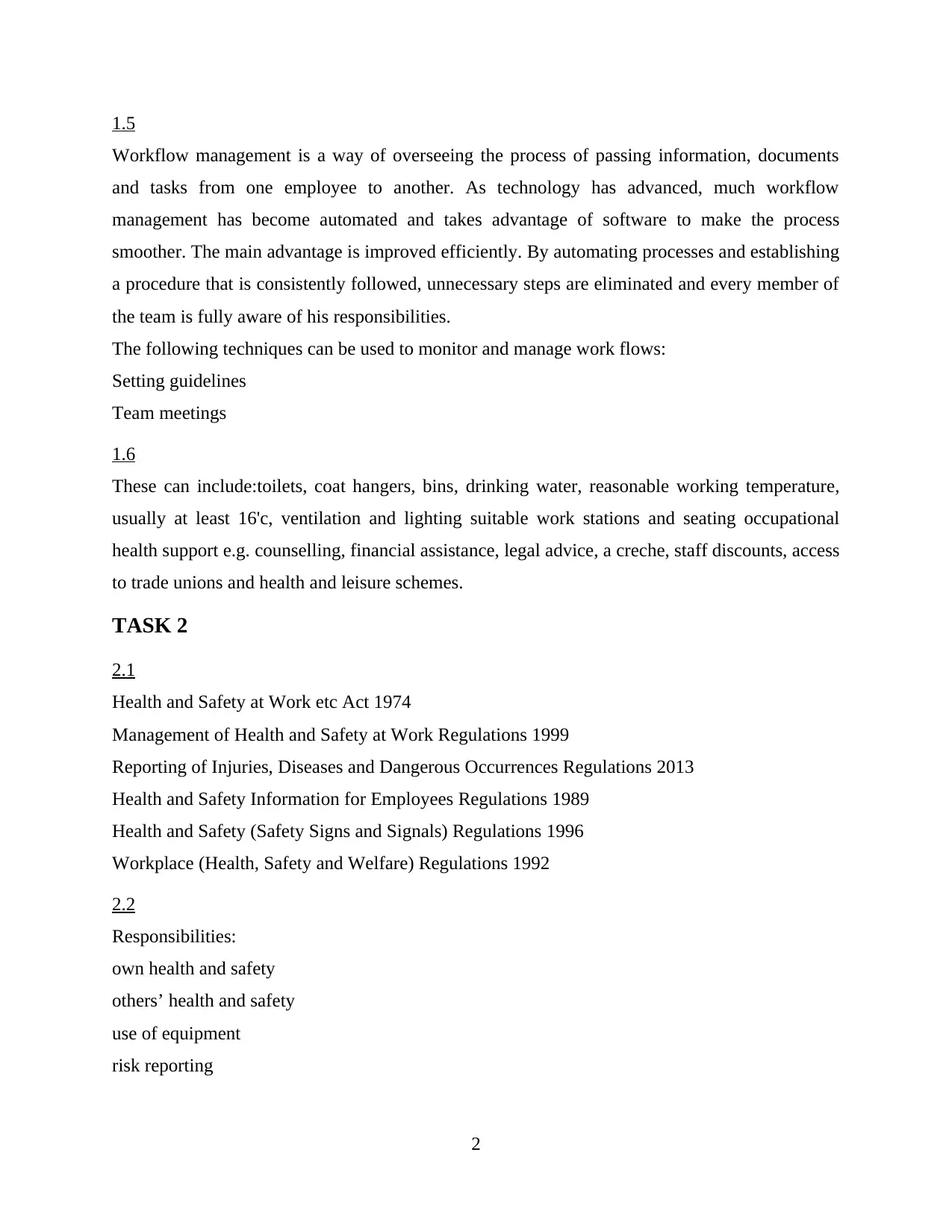
1.5
Workflow management is a way of overseeing the process of passing information, documents
and tasks from one employee to another. As technology has advanced, much workflow
management has become automated and takes advantage of software to make the process
smoother. The main advantage is improved efficiently. By automating processes and establishing
a procedure that is consistently followed, unnecessary steps are eliminated and every member of
the team is fully aware of his responsibilities.
The following techniques can be used to monitor and manage work flows:
Setting guidelines
Team meetings
1.6
These can include:toilets, coat hangers, bins, drinking water, reasonable working temperature,
usually at least 16'c, ventilation and lighting suitable work stations and seating occupational
health support e.g. counselling, financial assistance, legal advice, a creche, staff discounts, access
to trade unions and health and leisure schemes.
TASK 2
2.1
Health and Safety at Work etc Act 1974
Management of Health and Safety at Work Regulations 1999
Reporting of Injuries, Diseases and Dangerous Occurrences Regulations 2013
Health and Safety Information for Employees Regulations 1989
Health and Safety (Safety Signs and Signals) Regulations 1996
Workplace (Health, Safety and Welfare) Regulations 1992
2.2
Responsibilities:
own health and safety
others’ health and safety
use of equipment
risk reporting
2
Workflow management is a way of overseeing the process of passing information, documents
and tasks from one employee to another. As technology has advanced, much workflow
management has become automated and takes advantage of software to make the process
smoother. The main advantage is improved efficiently. By automating processes and establishing
a procedure that is consistently followed, unnecessary steps are eliminated and every member of
the team is fully aware of his responsibilities.
The following techniques can be used to monitor and manage work flows:
Setting guidelines
Team meetings
1.6
These can include:toilets, coat hangers, bins, drinking water, reasonable working temperature,
usually at least 16'c, ventilation and lighting suitable work stations and seating occupational
health support e.g. counselling, financial assistance, legal advice, a creche, staff discounts, access
to trade unions and health and leisure schemes.
TASK 2
2.1
Health and Safety at Work etc Act 1974
Management of Health and Safety at Work Regulations 1999
Reporting of Injuries, Diseases and Dangerous Occurrences Regulations 2013
Health and Safety Information for Employees Regulations 1989
Health and Safety (Safety Signs and Signals) Regulations 1996
Workplace (Health, Safety and Welfare) Regulations 1992
2.2
Responsibilities:
own health and safety
others’ health and safety
use of equipment
risk reporting
2
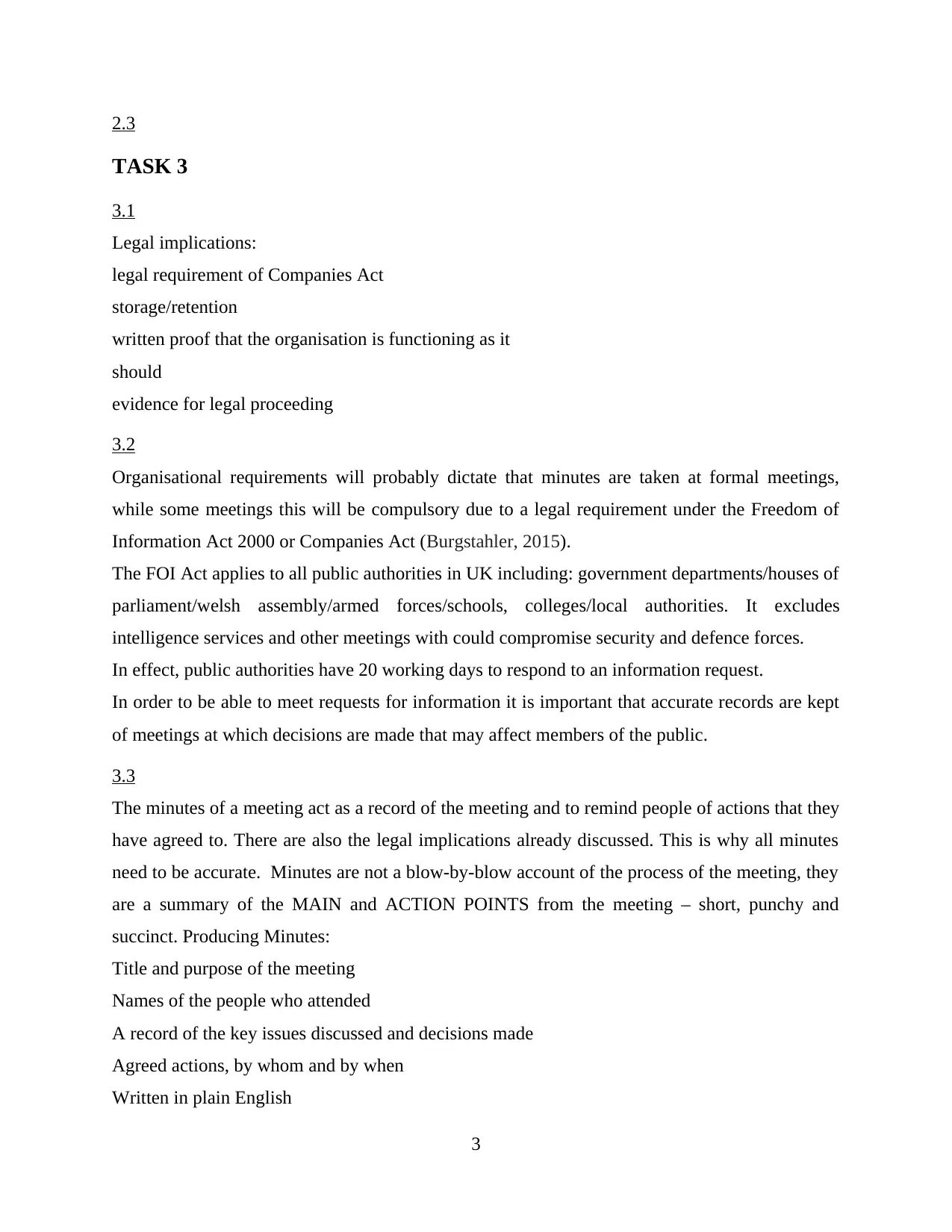
2.3
TASK 3
3.1
Legal implications:
legal requirement of Companies Act
storage/retention
written proof that the organisation is functioning as it
should
evidence for legal proceeding
3.2
Organisational requirements will probably dictate that minutes are taken at formal meetings,
while some meetings this will be compulsory due to a legal requirement under the Freedom of
Information Act 2000 or Companies Act (Burgstahler, 2015).
The FOI Act applies to all public authorities in UK including: government departments/houses of
parliament/welsh assembly/armed forces/schools, colleges/local authorities. It excludes
intelligence services and other meetings with could compromise security and defence forces.
In effect, public authorities have 20 working days to respond to an information request.
In order to be able to meet requests for information it is important that accurate records are kept
of meetings at which decisions are made that may affect members of the public.
3.3
The minutes of a meeting act as a record of the meeting and to remind people of actions that they
have agreed to. There are also the legal implications already discussed. This is why all minutes
need to be accurate. Minutes are not a blow-by-blow account of the process of the meeting, they
are a summary of the MAIN and ACTION POINTS from the meeting – short, punchy and
succinct. Producing Minutes:
Title and purpose of the meeting
Names of the people who attended
A record of the key issues discussed and decisions made
Agreed actions, by whom and by when
Written in plain English
3
TASK 3
3.1
Legal implications:
legal requirement of Companies Act
storage/retention
written proof that the organisation is functioning as it
should
evidence for legal proceeding
3.2
Organisational requirements will probably dictate that minutes are taken at formal meetings,
while some meetings this will be compulsory due to a legal requirement under the Freedom of
Information Act 2000 or Companies Act (Burgstahler, 2015).
The FOI Act applies to all public authorities in UK including: government departments/houses of
parliament/welsh assembly/armed forces/schools, colleges/local authorities. It excludes
intelligence services and other meetings with could compromise security and defence forces.
In effect, public authorities have 20 working days to respond to an information request.
In order to be able to meet requests for information it is important that accurate records are kept
of meetings at which decisions are made that may affect members of the public.
3.3
The minutes of a meeting act as a record of the meeting and to remind people of actions that they
have agreed to. There are also the legal implications already discussed. This is why all minutes
need to be accurate. Minutes are not a blow-by-blow account of the process of the meeting, they
are a summary of the MAIN and ACTION POINTS from the meeting – short, punchy and
succinct. Producing Minutes:
Title and purpose of the meeting
Names of the people who attended
A record of the key issues discussed and decisions made
Agreed actions, by whom and by when
Written in plain English
3
⊘ This is a preview!⊘
Do you want full access?
Subscribe today to unlock all pages.

Trusted by 1+ million students worldwide

Accurate
Concise
Grammatically correct
Objective
Remember: You do not need to include irrelevant comments only record those that are relevant
to the agenda.
Make a seating plan at the start of the meeting or send round a register.
Record those who arrive late or leave early.
Develop your own abbreviations – not too many otherwise it can get confusing.
Progress on minutes / deadlines should be recorded in the appropriate planning tool e.g. diary;
Microsoft Outlook.
3.4-
Resolution minutes
– record decisions not any detail about the discussion surrounding the decision
Narrative minutes
– summary of the main points of discussion and the decisions taken
Action minutes
– briefly report the proceedings and name the person delegated to undertake the action
3.5
If you are taking resolution or narrative minutes, your notes should record the discussion in such
a way that your minutes give a precise account of the points made for and against a proposal and
the reasons given in support of those points but not a word for word account. Motions,
amendments and resolutions must be recorded word for word, to prevent any dispute later
(Hiscox, 2015). Record the name of the person who proposed the motion, who seconded it and
the result of the vote.
TASK 4
4.1
Informal meetings:
departmental meetings
team briefings
4
Concise
Grammatically correct
Objective
Remember: You do not need to include irrelevant comments only record those that are relevant
to the agenda.
Make a seating plan at the start of the meeting or send round a register.
Record those who arrive late or leave early.
Develop your own abbreviations – not too many otherwise it can get confusing.
Progress on minutes / deadlines should be recorded in the appropriate planning tool e.g. diary;
Microsoft Outlook.
3.4-
Resolution minutes
– record decisions not any detail about the discussion surrounding the decision
Narrative minutes
– summary of the main points of discussion and the decisions taken
Action minutes
– briefly report the proceedings and name the person delegated to undertake the action
3.5
If you are taking resolution or narrative minutes, your notes should record the discussion in such
a way that your minutes give a precise account of the points made for and against a proposal and
the reasons given in support of those points but not a word for word account. Motions,
amendments and resolutions must be recorded word for word, to prevent any dispute later
(Hiscox, 2015). Record the name of the person who proposed the motion, who seconded it and
the result of the vote.
TASK 4
4.1
Informal meetings:
departmental meetings
team briefings
4
Paraphrase This Document
Need a fresh take? Get an instant paraphrase of this document with our AI Paraphraser

progress meeting
working parties
Every formal meeting has a person nominated to run the meeting. In different organisations this
person may be known as the chairman or chairwomen, the chair or chairperson. Attendance at
some meetings is mandatory.
Shareholder meeting:
Public limited companies (PLC) are required to hold a meeting at least once a year where all
shareholders are invited to attend.
Purpose - give shareholders the opportunity to question directors and vote on resolutions.
PLC's no longer have to hold AGM's but are able to hold shareholder meetings which can be
initiated by the director or 10% of the voting members (5% if it has been 12 months since the
members last met).
Board meetings
- these are regular meetings between the directors at which decisions are taken on the strategy to
be followed by the organisation.
Management meetings
- these are regular meetings held by senior managers to decide how the strategy of the
organisation is to be put into action on a practical level (Laihonen and Mäntylä, 2017).
4.2
The chairperson should know what the meeting is about, there may be a few occasions that the
chair has to be briefed. The responsibilities of the chairperson are:
start meeting on time
clarify roles and responsibilities
establish ground rules and responsibilities
participate as an attendee
close the meeting on time
The chairperson also has responsibilities to help the minute taker by :
agreeing the items to be included on the agenda
following agenda items in sequence and informing the minute taker of any departures from the
agreed agenda
summarising specific points, decisions or courses of action before moving on to the next item
5
working parties
Every formal meeting has a person nominated to run the meeting. In different organisations this
person may be known as the chairman or chairwomen, the chair or chairperson. Attendance at
some meetings is mandatory.
Shareholder meeting:
Public limited companies (PLC) are required to hold a meeting at least once a year where all
shareholders are invited to attend.
Purpose - give shareholders the opportunity to question directors and vote on resolutions.
PLC's no longer have to hold AGM's but are able to hold shareholder meetings which can be
initiated by the director or 10% of the voting members (5% if it has been 12 months since the
members last met).
Board meetings
- these are regular meetings between the directors at which decisions are taken on the strategy to
be followed by the organisation.
Management meetings
- these are regular meetings held by senior managers to decide how the strategy of the
organisation is to be put into action on a practical level (Laihonen and Mäntylä, 2017).
4.2
The chairperson should know what the meeting is about, there may be a few occasions that the
chair has to be briefed. The responsibilities of the chairperson are:
start meeting on time
clarify roles and responsibilities
establish ground rules and responsibilities
participate as an attendee
close the meeting on time
The chairperson also has responsibilities to help the minute taker by :
agreeing the items to be included on the agenda
following agenda items in sequence and informing the minute taker of any departures from the
agreed agenda
summarising specific points, decisions or courses of action before moving on to the next item
5

providing specific guidance to the minute taker on what to record for a particular agenda item
where lengthy discussion has occurred
Taking time to review the minutes when they are drafted.
4.3
Treasurer
- responsible for reporting on financial matters
Secretary
- is often the minute taker but this can be delegated. They ensure the required documentation and
any correspondence to be discussed or referred to at the meeting is available.
Attendees
- specific to the meeting and its purpose, may be staff, managers or stakeholders. Discuss and
agree agenda items.
4.4
Role and responsibilities:
setting the agenda
running the meeting
voting
approving the minutes
4.5
before, during and after a meeting
a notice sent to attendees,
an agenda,
a chairperson's agenda,
minutes,
reports,
briefings and
Correspondence.
Resources during the meeting will be:
Audio/visual equipment
pens, pencils and paper
6
where lengthy discussion has occurred
Taking time to review the minutes when they are drafted.
4.3
Treasurer
- responsible for reporting on financial matters
Secretary
- is often the minute taker but this can be delegated. They ensure the required documentation and
any correspondence to be discussed or referred to at the meeting is available.
Attendees
- specific to the meeting and its purpose, may be staff, managers or stakeholders. Discuss and
agree agenda items.
4.4
Role and responsibilities:
setting the agenda
running the meeting
voting
approving the minutes
4.5
before, during and after a meeting
a notice sent to attendees,
an agenda,
a chairperson's agenda,
minutes,
reports,
briefings and
Correspondence.
Resources during the meeting will be:
Audio/visual equipment
pens, pencils and paper
6
⊘ This is a preview!⊘
Do you want full access?
Subscribe today to unlock all pages.

Trusted by 1+ million students worldwide
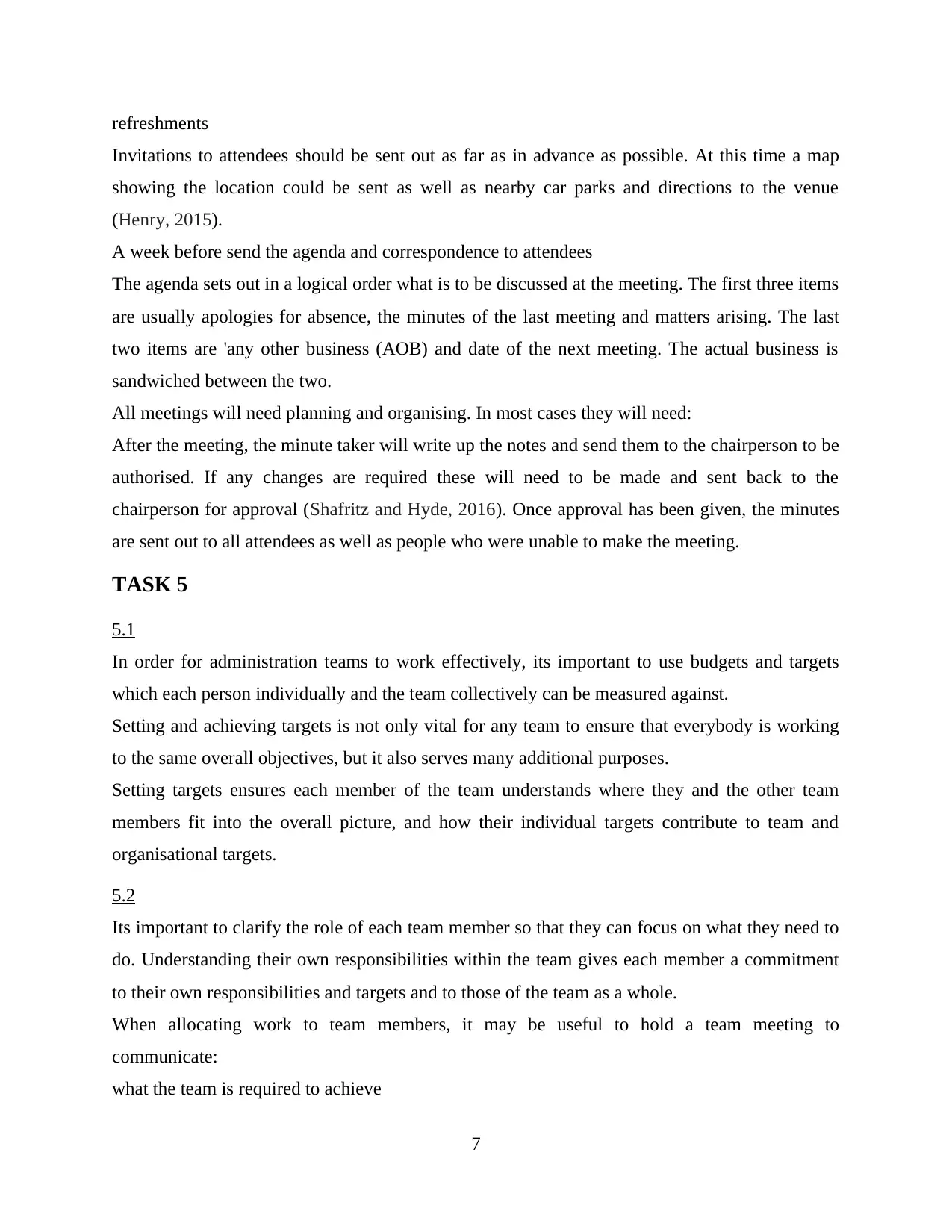
refreshments
Invitations to attendees should be sent out as far as in advance as possible. At this time a map
showing the location could be sent as well as nearby car parks and directions to the venue
(Henry, 2015).
A week before send the agenda and correspondence to attendees
The agenda sets out in a logical order what is to be discussed at the meeting. The first three items
are usually apologies for absence, the minutes of the last meeting and matters arising. The last
two items are 'any other business (AOB) and date of the next meeting. The actual business is
sandwiched between the two.
All meetings will need planning and organising. In most cases they will need:
After the meeting, the minute taker will write up the notes and send them to the chairperson to be
authorised. If any changes are required these will need to be made and sent back to the
chairperson for approval (Shafritz and Hyde, 2016). Once approval has been given, the minutes
are sent out to all attendees as well as people who were unable to make the meeting.
TASK 5
5.1
In order for administration teams to work effectively, its important to use budgets and targets
which each person individually and the team collectively can be measured against.
Setting and achieving targets is not only vital for any team to ensure that everybody is working
to the same overall objectives, but it also serves many additional purposes.
Setting targets ensures each member of the team understands where they and the other team
members fit into the overall picture, and how their individual targets contribute to team and
organisational targets.
5.2
Its important to clarify the role of each team member so that they can focus on what they need to
do. Understanding their own responsibilities within the team gives each member a commitment
to their own responsibilities and targets and to those of the team as a whole.
When allocating work to team members, it may be useful to hold a team meeting to
communicate:
what the team is required to achieve
7
Invitations to attendees should be sent out as far as in advance as possible. At this time a map
showing the location could be sent as well as nearby car parks and directions to the venue
(Henry, 2015).
A week before send the agenda and correspondence to attendees
The agenda sets out in a logical order what is to be discussed at the meeting. The first three items
are usually apologies for absence, the minutes of the last meeting and matters arising. The last
two items are 'any other business (AOB) and date of the next meeting. The actual business is
sandwiched between the two.
All meetings will need planning and organising. In most cases they will need:
After the meeting, the minute taker will write up the notes and send them to the chairperson to be
authorised. If any changes are required these will need to be made and sent back to the
chairperson for approval (Shafritz and Hyde, 2016). Once approval has been given, the minutes
are sent out to all attendees as well as people who were unable to make the meeting.
TASK 5
5.1
In order for administration teams to work effectively, its important to use budgets and targets
which each person individually and the team collectively can be measured against.
Setting and achieving targets is not only vital for any team to ensure that everybody is working
to the same overall objectives, but it also serves many additional purposes.
Setting targets ensures each member of the team understands where they and the other team
members fit into the overall picture, and how their individual targets contribute to team and
organisational targets.
5.2
Its important to clarify the role of each team member so that they can focus on what they need to
do. Understanding their own responsibilities within the team gives each member a commitment
to their own responsibilities and targets and to those of the team as a whole.
When allocating work to team members, it may be useful to hold a team meeting to
communicate:
what the team is required to achieve
7
Paraphrase This Document
Need a fresh take? Get an instant paraphrase of this document with our AI Paraphraser
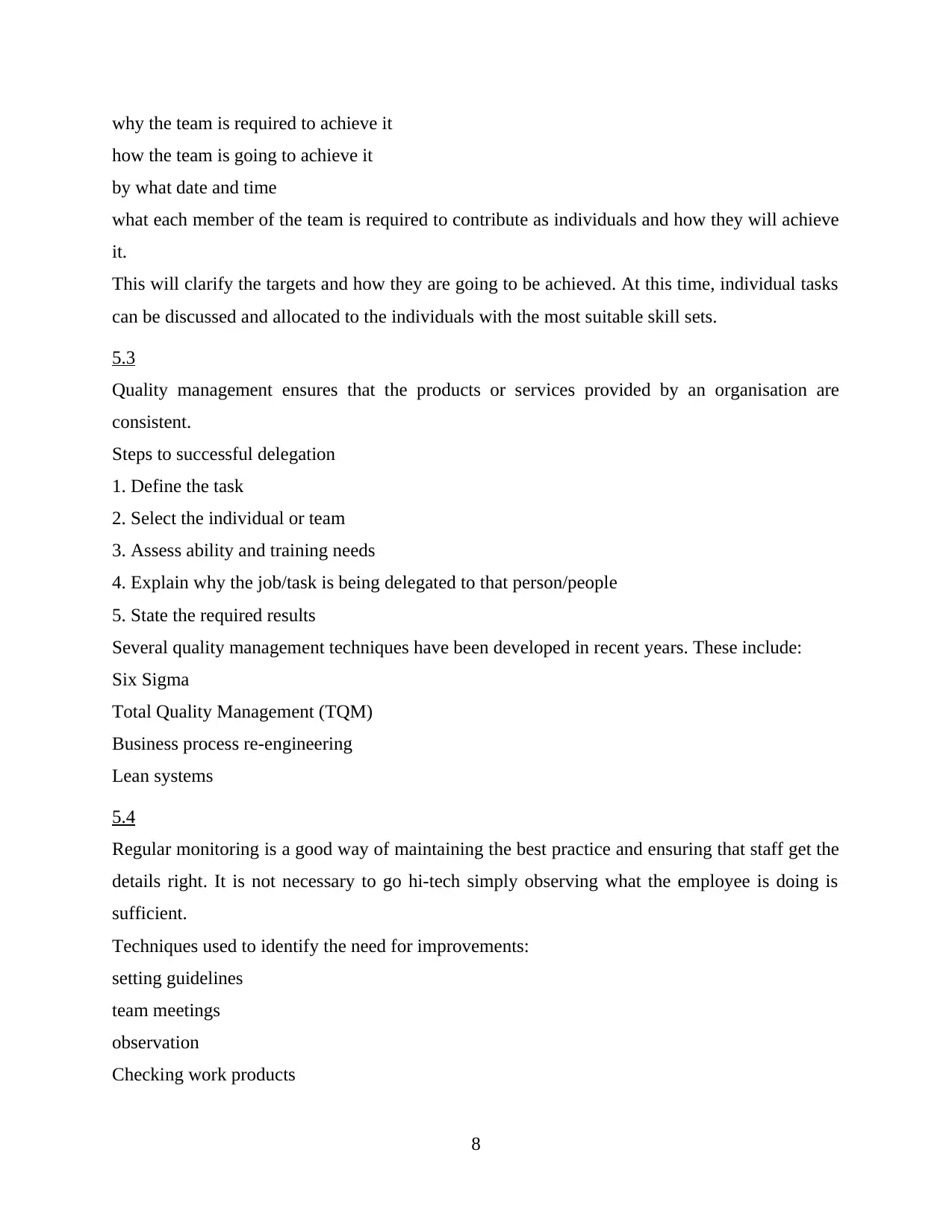
why the team is required to achieve it
how the team is going to achieve it
by what date and time
what each member of the team is required to contribute as individuals and how they will achieve
it.
This will clarify the targets and how they are going to be achieved. At this time, individual tasks
can be discussed and allocated to the individuals with the most suitable skill sets.
5.3
Quality management ensures that the products or services provided by an organisation are
consistent.
Steps to successful delegation
1. Define the task
2. Select the individual or team
3. Assess ability and training needs
4. Explain why the job/task is being delegated to that person/people
5. State the required results
Several quality management techniques have been developed in recent years. These include:
Six Sigma
Total Quality Management (TQM)
Business process re-engineering
Lean systems
5.4
Regular monitoring is a good way of maintaining the best practice and ensuring that staff get the
details right. It is not necessary to go hi-tech simply observing what the employee is doing is
sufficient.
Techniques used to identify the need for improvements:
setting guidelines
team meetings
observation
Checking work products
8
how the team is going to achieve it
by what date and time
what each member of the team is required to contribute as individuals and how they will achieve
it.
This will clarify the targets and how they are going to be achieved. At this time, individual tasks
can be discussed and allocated to the individuals with the most suitable skill sets.
5.3
Quality management ensures that the products or services provided by an organisation are
consistent.
Steps to successful delegation
1. Define the task
2. Select the individual or team
3. Assess ability and training needs
4. Explain why the job/task is being delegated to that person/people
5. State the required results
Several quality management techniques have been developed in recent years. These include:
Six Sigma
Total Quality Management (TQM)
Business process re-engineering
Lean systems
5.4
Regular monitoring is a good way of maintaining the best practice and ensuring that staff get the
details right. It is not necessary to go hi-tech simply observing what the employee is doing is
sufficient.
Techniques used to identify the need for improvements:
setting guidelines
team meetings
observation
Checking work products
8
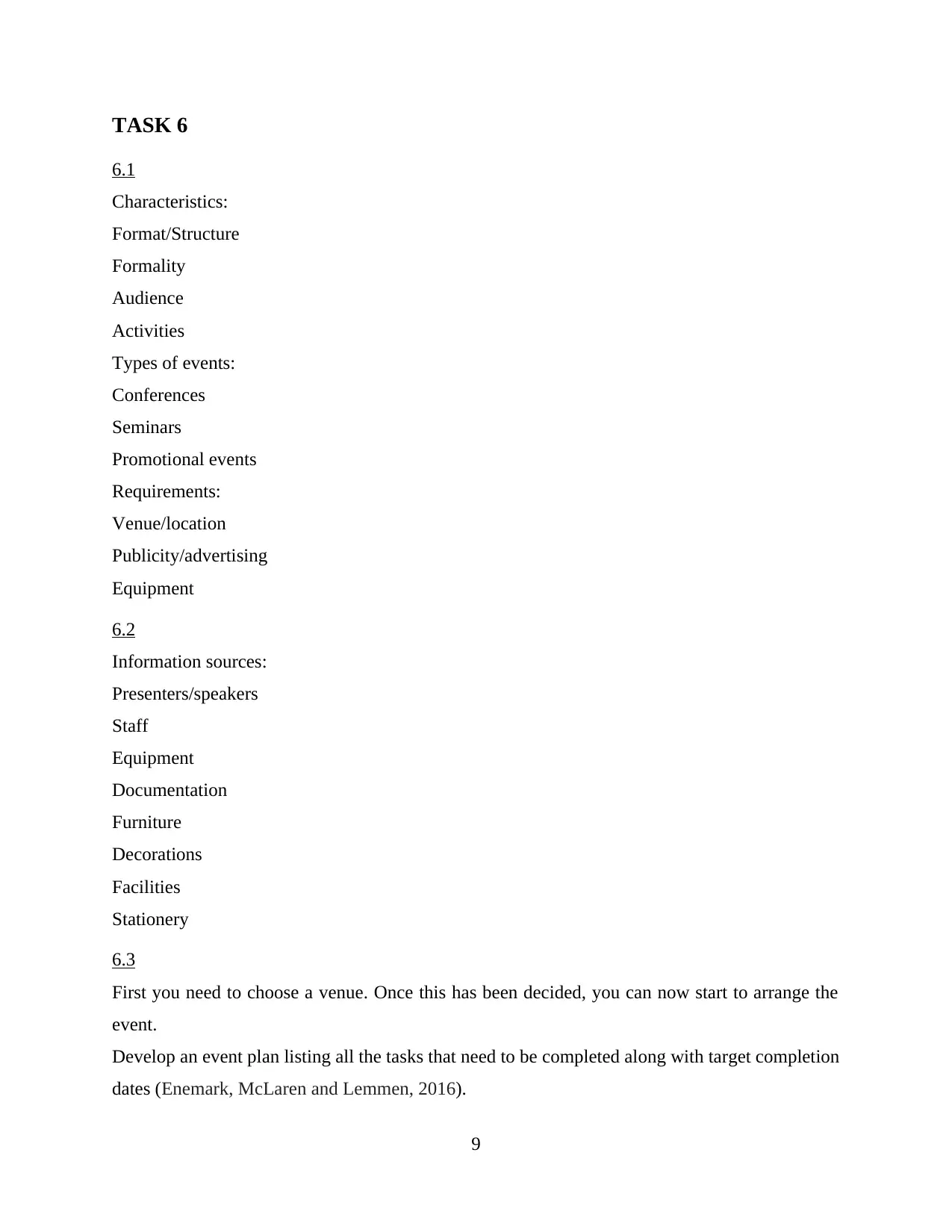
TASK 6
6.1
Characteristics:
Format/Structure
Formality
Audience
Activities
Types of events:
Conferences
Seminars
Promotional events
Requirements:
Venue/location
Publicity/advertising
Equipment
6.2
Information sources:
Presenters/speakers
Staff
Equipment
Documentation
Furniture
Decorations
Facilities
Stationery
6.3
First you need to choose a venue. Once this has been decided, you can now start to arrange the
event.
Develop an event plan listing all the tasks that need to be completed along with target completion
dates (Enemark, McLaren and Lemmen, 2016).
9
6.1
Characteristics:
Format/Structure
Formality
Audience
Activities
Types of events:
Conferences
Seminars
Promotional events
Requirements:
Venue/location
Publicity/advertising
Equipment
6.2
Information sources:
Presenters/speakers
Staff
Equipment
Documentation
Furniture
Decorations
Facilities
Stationery
6.3
First you need to choose a venue. Once this has been decided, you can now start to arrange the
event.
Develop an event plan listing all the tasks that need to be completed along with target completion
dates (Enemark, McLaren and Lemmen, 2016).
9
⊘ This is a preview!⊘
Do you want full access?
Subscribe today to unlock all pages.

Trusted by 1+ million students worldwide
1 out of 15
Related Documents
Your All-in-One AI-Powered Toolkit for Academic Success.
+13062052269
info@desklib.com
Available 24*7 on WhatsApp / Email
![[object Object]](/_next/static/media/star-bottom.7253800d.svg)
Unlock your academic potential
Copyright © 2020–2025 A2Z Services. All Rights Reserved. Developed and managed by ZUCOL.





